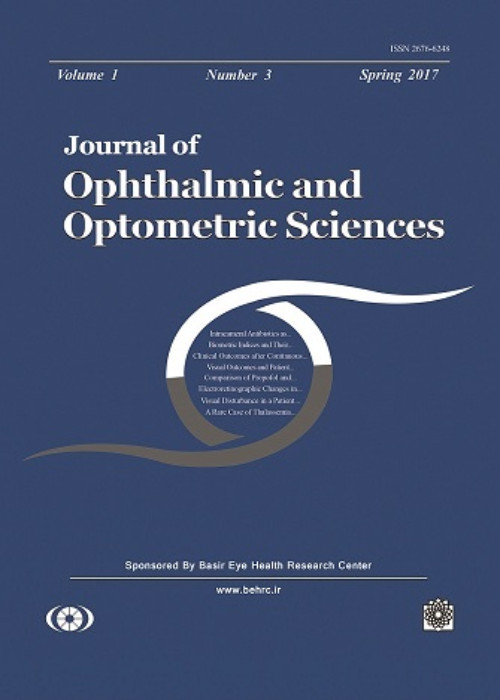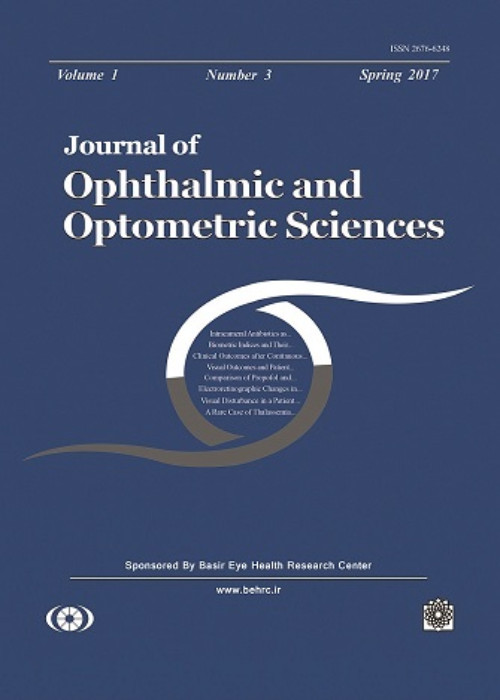فهرست مطالب

Journal of Ophthalmic and Optometric Sciences
Volume:6 Issue: 2, Spring 2022
- تاریخ انتشار: 1402/06/30
- تعداد عناوین: 6
-
-
Page 1Background
Myopia, also known as shortsightedness, is a common eye disorder characterized by a refractive error of the eye. It is estimated that by 2050, over 1 billion people will be affected by myopia. Recent studies have shown that miRNAs play a significant role in the genetic factors contributing to myopia. However, the current understanding of the number and role of certain miRNAs in myopia is limited. This study aims to identify unknown miRNAs and their involvement in high myopia.
Materials and MethodsThe raw dataset (GSE142359), consisting of miRNAs, was obtained from the GEO database. The dataset includes 10 samples, 5 from patients with high myopia and 5 from controls. Differentially expressed genes were identified using the EdgeR package in R software. The most significant miRNAs were then entered as input into the miRWalk web tool and target genes were identified. Subsequently, the PPI network was extracted using STRING and 10 clusters were identified. After that, we selected the most related cluster with myopia. Finally, we used DGIdb to identify candidate drugs for treatment of high myopia.
ResultsA total of 136 miRNAs were identified as significant differentially expressed miRNAs (DEmiRNAs). Then, we constructed miRNA-mRNA bipartite network with 564 interactions including 490 genes and 50 miRNAs. Afterwards, 5 miRNAs including: hsa-miR-195-5p, hsa-miR- 24-3p, hsa-miR-16-5p, hsa-miR-181b-5p, and hsa-miR-130a-3p and 8 proteins including ESR1, BCL2, VEGFA, FGF2, MAPK14, H2AX, APP, and MAP3K10 were identified. Finally, two new miRNAs including hsa-miR-195-5p and hsa-miR-24-3p, and three novel proteins including: ESR1, BCL2, and MAPK14 were proposed as potential biomarker in high myopia.
ConclusionThis study revealed new miRNAs previously unknown in highly myopic eyes through bioinformatics analysis. The identified candidate miRNAs and their related drug targets and genes can serve as potential biomarkers, improving the understanding of new therapeutic targets for highly myopic eyes.
Keywords: Myopia, NGS Data, MicroRNA, Differential Gene Expression, Drug- Gene Network -
Page 2Aim
Orbital fractures are complex facial fractures that require careful treatment to prevent visual complications. One suitable technique for assessing visual pathway disturbances in these patients is visual evoked potential. This study aims to record and analyze visual evoked potentials in patients with orbital fractures in order to improve understanding and treatment of this condition.
Materials and MethodsTwenty patients with severe orbital fractures and resulting visual impairment in eleven eyes were referred to Basir Eye Clinic for treatment. The patients, mostly males, were between the ages of 15 and 35. In order to assess their visual function, visual evoked potentials (VEP) were recorded using flash stimulation. The latency (in milliseconds) and amplitude (in microvolts) of the P100 component of the VEP were measured in the patient group and compared to a control group of 11 individuals matched for age and sex who had a healthy visual system.
ResultsThe mean age of inpatient and healthy groups was respectively 24.25 ± 6.52 and 24.25 ± 6.56. The study included two groups with an equal number of males and females. There, no statistically significant difference in terms of age and sex between the two groups. The best corrected visual acuity (BCVA) showed a large difference between the two groups, with the patients having only light perception ability while the control group had full vision (10/10). The mean latency for VEP100 peak was 130.36 ± 8 in the case group and 99.63 ± 2.33 in the control group. The mean amplitude was 1.27 ± 0.46 in the case group and 4.27 ± 0.78 in the control group. Both the latency and amplitude of VEP100 peak showed significant differences between the case and control groups (P < 0.001).
ConclusionHead trauma can result in eye dysfunction, primarily affecting the visual pathway. One way to diagnose this condition is by measuring the latency and amplitude of the VEP p1000 peak.
Keywords: Orbital Fracture, Visual Disturbances, Flash Visual Evoked Potential -
Page 3Background
Although DNA isolation using the commercial chelex 100 is inexpensive and fast, the DNA gained by this method shows a low concentration and is of poor quality in certain materials, such as hairs; high amount of DNA will also inhibit the efficiency of the PCR amplification.
Material and MethodsIn the present study, we have improved a hair DNA isolation approach based on chelex 100, where ammonium acetate was added to precipitate proteins, ethanol was used to pellet out DNA, and glycogen was applied as a carrier of successful DNA recovery.
ResultAs a result, we obtained high quality of DNA, which can be successfully used for authentic STR analysis from one single hair. We also noticed that the DNA dilution from 25 to 125 fold presented very good quality for short-tandem-repeat (STR) genotyping by only chelex 100 extraction, demonstrating the efficiency for STR genotyping can be improved by dilution of PCR inhibitors or other unknown inhibitors.
ConclusionTaken together, our improved extraction and dilution of DNA would be used as an option for the application of hair STR analysis in judicial authentication and forensic sciences. This method may be usable for other samples, such as, eyelashes, eyebrows, tissues, sperms and blood samples in human and animals for STR genotype or DNA fingerprinting, and genetics diagnosis including retinal diseases.
Keywords: Short-tandem-repeat (STR), Genotype, Hair, DNA extraction, Genetics -
Page 4Background
The wave-like characteristics of light lie at the heart of Optical Coherence Tomography (OCT), a non-invasive imaging technique widely utilized in ophthalmology. This technique provides detailed, high-resolution images of the intricate internal structure of the eye. This review is dedicated to providing a comprehensive understanding of the foundational principles of OCT, tracing its progression from time-domain to Fourier-domain methodologies, and examining the substantial advancements that have profoundly transformed its role in ophthalmological diagnostics.
Material and MethodsOur methodology involves a comprehensive literature review. The review begins with a meticulous exploration of the fundamental principles of OCT, delving into its profound connection with the wave-like nature of light. We then proceed with an in-depth examination of the progression of OCT methodologies, tracing their journey from time-domain to Fourier-domain. This is followed by an exhaustive discussion of the most recent advancements in OCT technology, including the emergence of vis-OCT, AO-OCT, PS-OCT, High-Res OCT, and FFOCT.
ResultsSince its inception, OCT has undergone several evolutions, with each advancement contributing to improved image resolution, increased acquisition speed, and enhanced imaging depth. These technological advancements have allowed for a more precise and early detection of various ocular conditions. Furthermore, innovations such as vis-OCT, AO-OCT, and others, have demonstrated their potential in expanding OCT’s diagnostic capabilities.
ConclusionsThe continual evolution and refinement of OCT technology underscore its critical role in enhancing our understanding of the eye’s microstructure and contribute to more effective diagnostic strategies and targeted interventions for various ocular pathologies. As OCT technology continues to evolve, it promises an exciting future for eye care, with possibilities for even more advanced imaging techniques, better diagnostics, and improved patient care.
Keywords: Optic Coherence Tomography (OCT), AO-OCT, PS-OCT -
Page 5Background
Beta-thalassemia is an inherited blood disorder that leads to early apoptosis of red blood cells (RBCs), ineffective erythropoiesis, and ocular complications. The disease is classified into beta-thalassemia minor (β-TMi), beta-thalassemia intermedia (β-TI), and beta-thalassemia major (β-TM).We aim to review various functional and structural ocular manifestations of β-TM patients in different studies and present the most important findings based on the prevalence and etiologies of each ocular complication.
Materials and methodsTo reach this purpose, we developed a search strategy using the keywords “eye disease,” “ocular complications,” “ocular manifestations,” and “ocular abnormality,” each with “beta-thalassemia” in the two popular search engines PubMed and Google Scholar up to December 2022. We also reviewed related references of the chosen papers.
ResultsAccording to the literature review, the most consistent is the correlation of β-TM with dry eye disease and fundus alterations, while there are still many challenges regarding the prevalence and etiologies of other ocular complications in β-TM patients.
ConclusionThis finding warrants studies with larger sample sizes to reach more reliable results and take them into action for preventing and timely diagnosing such ocular complications.
Keywords: Beta-Thalassemia Major, Ocular Complications, Iron Chelation Therapy, Iron Overload -
Page 6
Cardiac surgery describes any surgical procedure involving the heart or the blood vessels carrying blood to and from it. It is usually a safe surgery regarding the visual system; however, in rare cases, due to certain complications, a devasting consequence occurs, leading to total blindness in patients. In this regard, a central vision loss in a 62-year-old patient following cardiovascular surgery is reported.


